
- 320 pages
- English
- ePUB (mobile friendly)
- Available on iOS & Android
eBook - ePub
About this book
"An engaging retrospective on the long-lived and ubiquitous C-130 Hercules tactical airlifter . . . Sweeping in its scope . . . an invaluable reference." —
Aviation History
Designed in response to a 1951 requirement, the C-130 Hercules is the most successful military airlifter ever built. Since it first flew in prototype form on August 23, 1954, more than 2,100 have been produced in over eighty different versions. Across its variants, the Hercules serves more than sixty air forces, as well as many civilian cargo operators, in a multiplicity of roles, including air-to-air refueller, gunship, airborne command post, flying hospital, and firefighter.
This rugged and easily maintained aircraft entered service in 1956 with the USAF Tactical Air Command. Ten years later, the "Charlie 130" was providing essential logistical support in Vietnam. This period in Southeast Asia was the Hercules' finest hour. Paradrops, airlift, and evacuation operations were completed around the clock, often at low level, usually under fire and nearly always in bad weather.
A generation later, this "Mr. Dependable" was serving with equal distinction in the Gulf War in the role of airlifter, radio-countermeasures, and "psy-ops" platform, gunship and, once again, "block-buster bomber." The "Herky Bird" or "Fat Albert," as the C-130 is fondly known, has proved a key component in humanitarian relief operations, as well, in all parts of the world.
"Martin's technical and informative look at their creation and use is absolutely fascinating. An iconic aircraft gets Martin's VIP treatment in this wonderful book." —Books Monthly
"A history of an aviation great, from the pen of a popular and well-established author of aviation history." —Firetrench
Designed in response to a 1951 requirement, the C-130 Hercules is the most successful military airlifter ever built. Since it first flew in prototype form on August 23, 1954, more than 2,100 have been produced in over eighty different versions. Across its variants, the Hercules serves more than sixty air forces, as well as many civilian cargo operators, in a multiplicity of roles, including air-to-air refueller, gunship, airborne command post, flying hospital, and firefighter.
This rugged and easily maintained aircraft entered service in 1956 with the USAF Tactical Air Command. Ten years later, the "Charlie 130" was providing essential logistical support in Vietnam. This period in Southeast Asia was the Hercules' finest hour. Paradrops, airlift, and evacuation operations were completed around the clock, often at low level, usually under fire and nearly always in bad weather.
A generation later, this "Mr. Dependable" was serving with equal distinction in the Gulf War in the role of airlifter, radio-countermeasures, and "psy-ops" platform, gunship and, once again, "block-buster bomber." The "Herky Bird" or "Fat Albert," as the C-130 is fondly known, has proved a key component in humanitarian relief operations, as well, in all parts of the world.
"Martin's technical and informative look at their creation and use is absolutely fascinating. An iconic aircraft gets Martin's VIP treatment in this wonderful book." —Books Monthly
"A history of an aviation great, from the pen of a popular and well-established author of aviation history." —Firetrench
Frequently asked questions
Yes, you can cancel anytime from the Subscription tab in your account settings on the Perlego website. Your subscription will stay active until the end of your current billing period. Learn how to cancel your subscription.
No, books cannot be downloaded as external files, such as PDFs, for use outside of Perlego. However, you can download books within the Perlego app for offline reading on mobile or tablet. Learn more here.
Perlego offers two plans: Essential and Complete
- Essential is ideal for learners and professionals who enjoy exploring a wide range of subjects. Access the Essential Library with 800,000+ trusted titles and best-sellers across business, personal growth, and the humanities. Includes unlimited reading time and Standard Read Aloud voice.
- Complete: Perfect for advanced learners and researchers needing full, unrestricted access. Unlock 1.4M+ books across hundreds of subjects, including academic and specialized titles. The Complete Plan also includes advanced features like Premium Read Aloud and Research Assistant.
We are an online textbook subscription service, where you can get access to an entire online library for less than the price of a single book per month. With over 1 million books across 1000+ topics, we’ve got you covered! Learn more here.
Look out for the read-aloud symbol on your next book to see if you can listen to it. The read-aloud tool reads text aloud for you, highlighting the text as it is being read. You can pause it, speed it up and slow it down. Learn more here.
Yes! You can use the Perlego app on both iOS or Android devices to read anytime, anywhere — even offline. Perfect for commutes or when you’re on the go.
Please note we cannot support devices running on iOS 13 and Android 7 or earlier. Learn more about using the app.
Please note we cannot support devices running on iOS 13 and Android 7 or earlier. Learn more about using the app.
Yes, you can access C-130 Hercules by Martin W. Bowman in PDF and/or ePUB format, as well as other popular books in History & Military & Maritime History. We have over one million books available in our catalogue for you to explore.
Information
Chapter One
By The Numbers
A C-130 was lumbering along when a cocky F-16 flashed by. The jet jockey decided to show off. The fighter jock told the C-130 pilot, ‘watch this!’ and promptly went into a barrel roll followed by a steep climb. He then finished with a sonic boom as he broke the sound barrier. The F-16 pilot asked the C-130 pilot ‘What he thought of that?’ The C-130 pilot said ‘That was impressive, but watch this!’ The C-130 droned along for about five minutes and then the C-130 pilot came back on and said, ‘What did you think of that?’Puzzled, the F-16 pilot asked, ‘What the heck did you do?’ The C-130 pilot chuckled. ‘I stood up, stretched my legs, walked to the back, went to the bathroom, then got a cup of coffee and a cinnamon bun.
Everyone knows the Hercules - even those who are unaware of its C-130 military designation know exactly what it is for and what it does, this bulky, squat, but lovable aircraft with the reassuring friendly face of a seal pup and whaled tail. In RAF circles it goes by the name of Fat Albert’ and in Việtnam it soon earned sardonic affection as the ‘trash hauler’ - at least, that’s what the ‘fast movers’ (fighter pilots) called it.
If the decision by Lockheed in the fifties to reject conventional piston engines in favour of the newer and less proven technology of turboprops had been a brave one, then the decision to create a state-ofthe-art Hercules for the 21st century was an unparalleled step. Such technological advances were not even a remote possibility in the early fifties when the USAF developed requirements for a new tactical aircraft based on the lessons being learned in the Korean War. Even so, in 1950 an idea - a pipe-dream almost - for an aircraft that could carry a 30,000lb payload of freight or troops over a distance of 1,500 nautical miles and could land and take off from difficult terrain, was reportedly thrown into a brainstorming meeting at the Pentagon by an unknown USAF colonel. At this time the request was akin to trying to send a manned vehicle to the moon. Certainly, it was almost technically impossible, given the limit of engine and airframe development at this time. However, a more formal operational requirement developed from the original idea and requests for proposals were issued to Boeing, Douglas, Fairchild and Lockheed.
The Air Force demanded responses within two months. The Burbank advanced design department made its submission on time and the Model L-206, as it was called, was judged the winner out of the four contenders. Lockheed had opted for an uncomplicated, workmanlike design for the airlifter, but had made what it thought was a brave decision by rejecting conventional piston engines and going for the newer and less proven technology of turboprops.
The designers proved their detractors wrong. The first Hercules entered service in 1956 with the USAF Tactical Air Command. Ten years later, when America became involved in the Việtnam War, it was the Hercules that moved troops and equipment from the US base at Naha, Okinawa, to South Việtnam. At the peak of the war effort there were fifteen squadrons of C-130s permanently assigned for Tactical Air Command or temporary deployment duties. Although around fifty Hercules aircraft were lost in Việtnam, the C-130 had more than distinguished itself, not just in troop and cargo movements but in many other important roles, too. For instance, it was the last aircraft out of Saïgon in 1975 and was jam-packed with people: there were 475 reported on board, fifty of them crammed into the flight deck!
Since then, the Hercules has never been far from the front line. It has continued to prove to be a most flexible workhorse, while its humanitarian role may account for the great affection which the Hercules seems to inspire; it even boasts its own civilian fan club!
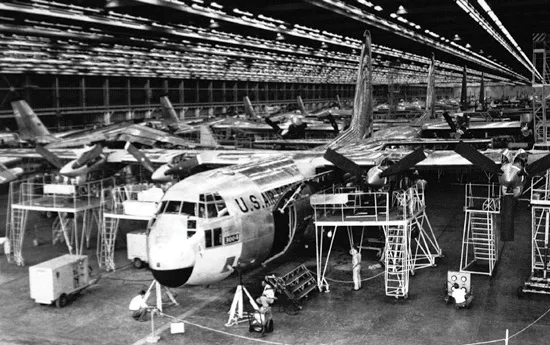
C-130A assembly line with 53-3132 (c/n 3004) at the head of the line which was delivered in December 1956.
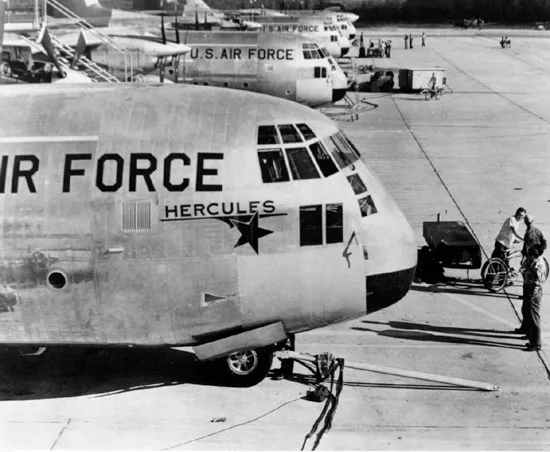
Line up of the very early production C-130As, the first seven of which were ordered by the Air Force in February 1953. (Lockheed)
The C-130’s reputation was such that one US colonel proclaimed that it was the only airplane of which it could be said that if it had been grounded, then the war would have ended. Universally this ‘Mr Dependable’ is fondly referred to as the ‘Herky Bird’. In the twenty years since the Việtnam War this priceless aircraft has written its own chapter in aviation history as the world’s most successful military airlifter. For when military cargo and heavy equipment have to be delivered into trouble zones - or soldiers and paratroops, or people, relief supplies and medical aid, or if the need to be evacuated from war and famine, then the success of the operation depends on this immensely reliable and versatile airlifter. When there are labours to be done, whether they be military support or international relief, the Hercules is usually there, swirling the dust in the middle of desert wastes, being put down on a remote jungle strip, or landing on bomb-scarred runways at warravaged airports, delivering cargo or airdropping supplies.
For forty years the Hercules has come to the aid of countless thousands in every part of the world. Name a continent and the Hercules has invariably been there and usually more than once - seen it, done it and if it hasn’t, is doing it tomorrow. Normally it is in the background, beavering away, earning its keep, not so much an unsung hero, but more a faithful friend we have all met somewhere before and have begun to take for granted. Sometimes, though, at Khê Sanh, Entebbe and Sarajevo, to name but a few, the Hercules has taken centre stage. At Khê Sanh in 1968 6,000 marines were entirely dependent on air supplies and the C130s delivered everything, often in foul weather conditions and in the face of enemy opposition, for seventy-one days almost non-stop. Pilots used what came to be known as the ‘Khê Sanh’ approach, a method whereby the aircraft stays high, only nosediving towards the landing strip at the last moment so as to avoid anti-aircraft fire for as long as possible.
More than 2,100 of these muchloved aircraft have been built and yet the design did not please everyone when it first appeared in 1954 - Kelly Johnson, who generated many wonderful sleek designs - the Starfighter and the SR-71 ‘Blackbird’ included - at the Burbank ‘Skunk Works’, called the Hercules ‘ugly’. Granted, the C-130 has never been sylph-like and it can be uncomfortable, especially riding back there in the hold - but ugly? Never! Its rotund appearance has tended to hide several novel features, including four turboprop engines capable of reverse thrust, large low-pressure tyres semi-recessed into undercarriage blisters and a rugged, simple construction that was designed from the outset to operate from rough or semi-prepared grass- or sand-strips with the minimum of support. This ‘ugly duckling’ has undergone five major facelifts and countless modifications, while some show stretch marks having been lengthened to carry civil and military cargo in the L-100 configuration. These changes have resulted in a myriad number of successful variants, including gunship, bomber, air-to-air refueller, airborne command post, AWACS, fire-fighter and even airborne hospital: but the Hercules has always managed to retain the same familiar characteristics and proven pedigree that it has enjoyed since it first took to the skies on 23 August 1954.
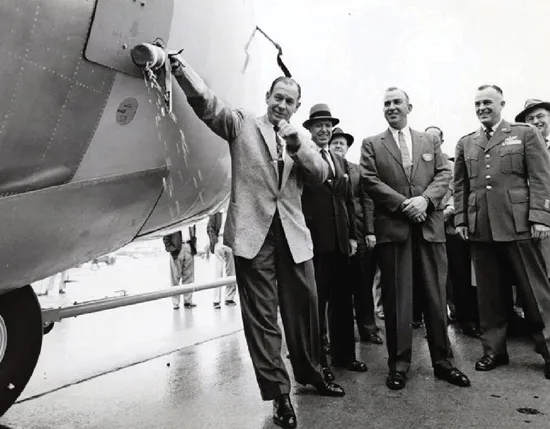
Samuel Marvin Griffin, Sr, the 72nd Governor of Georgia from 1955 to 1959, christening the first C.130 with a bottle of Chattahoochee River water.

Sixty years later, Governor Nathan Deal got a little wet during the commemorative christening ceremony Tuesday, April 15, 2015 of the latest C-130J. The bottle contained Chattahoochee River water just as Governor Marvin Griffin used during the christening 60 years earlier. (both Lockheed Martin)
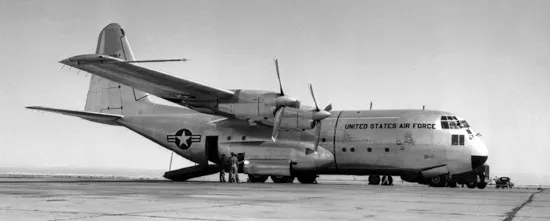
YC-130 prototype 53-3397. (Lockheed)
In January 1951 Lockheed reopened Plant 6, a government-built factory at Marietta, fifteen miles from Atlanta, Georgia and the complex was used to revamp B-29s and then build 394 Boeing B-47E Stratojets. The vast 76-acre site was now destined to build another aircraft in far greater numbers, because on 2 February 1951 the USAF issued a request for proposals (RFP) to Boeing, Douglas, Fairchild and Lockheed for a medium transport to replace the Fairchild C-119 tactical troop and cargo transport, which had proved underpowered and offering little improvement over the C-46 and C47 transports. A replacement for the ‘Flying Boxcar’ was of paramount importance, particularly in view of the escalation of and American involvement in, the Korean War, which had broken out in June 1950. The new medium-size transport had to be able to carry 92 infantrymen or 64 paratroopers over 2,000 miles for tactical missions, or for logistic missions, a 30,000lb load (including bulldozers, trucks, road-graders and howitzers) over 950 nautical miles (all without refuelling). Also, it had to operate if required from short and unprepared airstrips; and it had to be capable of slowing down to 125 knots for paradrops (made through two side doors) and even more slowly for steep ‘assault’ landings. A critical requirement was that it had to perform with one engine out over the drop zone and this had to be taken into consideration.

Prototype AC-130A 54-1626 Vulcan Express with camouflage paint applied. This aircraft was later retired to the USAF Museum in May 1976 and put on display. (USAF)
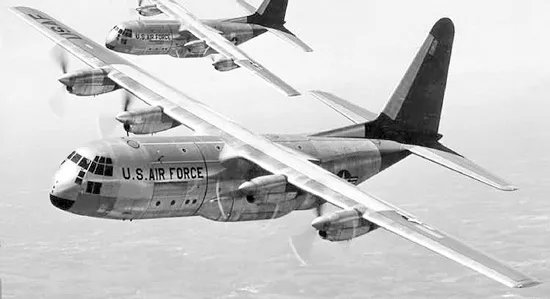
YC-130 prototypes YC-130 53-3396 and 53-3397 in formation.
At Lockheed-Burbank, Art Flock and his design team under the supervision of Willis Hawkins, head of the advanced design department, went to work on temporary design designation L206. It would have to be an amalgam of jeep, truck and aircraft. Flock opted for four engines instead of two, even though this decision would make the L-206 more expensive than its competitors. No turbine-powered transports had ever been produced in the USA before and it was a surprise therefore, when the slim-line 3,750eshp Allison T56-A-1A turbine driving three-bladed, variable-pitch, constant-speed propellers was chosen. But these gave the L-206 a top speed of 360 mph, faster than any other tactical transport; and pitch could be reversed to enable crews to stop quickly and back up the aircraft on a short field. Pressurization was essential because was that, having delivered troops and cargo, the new transport had to be able to accommodate 74 litter patients and two medical attendants and evacuate them from the battle area. ‘Kelly’ Johnson did not favour the ‘bulky’ shape but the dependable, sturdy new transport was not designed to break the sound barrier. From the outset it was a thoroughbred, but a workhorse and not a steed, conceived only to toil and sweat down in the dust, ice lakes and jungle clearings, places where grace and beauty have no place - designed to get the job done and get out again, preferably all in one piece. However, the entire fuselage was airconditioned and heated and the Hercules was one of the first aircraft to use air bled from the engines to supply the air-conditioning and pressurization systems. Its basic mission weight being only 108,000lb was due to the widespread use of machined skins with integral stiffening - one section for the upper and lower wing surfaces was 48 feet long - which largely eliminated riveting and in the process, produced a much stronger and more robust surface structure. More weight was saved by using 300lb of titanium on engine nacelles and wing flaps, while another new development in the form of high-strength aluminium alloys was used throughout the aircraft’s overall structure. In an age when complexity in aircraft design seemed to be the byword, the simple Hercules design consisted of only about 75,000 parts.
The Lockheed proposal was submitted in April 1951 along with the three other manufacturers and on 2 July was declared the winner. There followed a contract for two YC-130 (Model 82) prototype/service-test aircraft, which would be built at Burbank and on 19 September 1952. And the Pentagon issued a letter contract for seven C-130A production aircraft (Model 182) which would be built in Marietta. On 10 February 1953 most of the design team moved to Georgia. Al Brown was chosen as C-130 project engineer. The first prototype was used initially for static tests. The second YC-130 prototype first flew at the Lockheed air terminal on 23 August 1954 wit...
Table of contents
- Cover
- Title
- Copyright
- Contents
- Chapter 1 By The Numbers
- Chapter 2 Trash Haulers - The Workhorse of the Việtnam War
- Chapter 3 The Last Flight of The ‘Stray Goose’ Colonel John Gargus, USAF (Ret)
- Chapter 4 Haul On Call
- Chapter 5 Operation ‘Dragon Rouge’
- Chapter 6 Operation ‘Thunderbolt’
- Chapter 7 Operation ‘Eagle Claw’
- Chapter 8 The Quiet Professionals
- Chapter 9 The Antipodean Hercules
- Chapter 10 Conflict, Comfort, Relief, Hope and Enduring Freedom
- Chapter 11 That Eagles May Fly
- Chapter 12 The 21st Century Hercules
- Appendix Section
- Acknowledgements